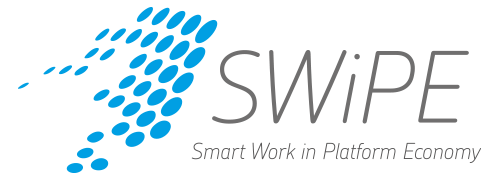
© Maria Grönroos, Studio Liikkuva
The discussion about the digitalisation of work is often conducted with technology in front. Hamid Ekbia and Bonnie Nardi from the US (2017) add a refreshing perspective to the discussion in their book Heteromation and other stories of computing and capitalism: Despite the technology, all value is based on human work, or at least in human activity. The part made by a person is often left invisible.
The authors’ background is in informatics, especially in the human-machine interaction, but in this book they look at digital activity from the perspectives of political economics and value creation.
Heteromation is a new logic of value creation based on digitechnology. The authors divide the economic history of computerisation in three eras: the automation that intensified after the Second World War aimed to replace the machines with people. In addition to this, from the 1970 onwards, the idea of increasing human intelligence, “symbiosis of a human and computer”, was developed. The focus of technological increase shifted from organisations to individuals and people’s daily work and life, and later through the Internet to large crowds. Heteromation is a concept that people are involved in the value creation activities, but they themselves benefit from creating monetary value only little or not at all. Heteramation is always associated with the creation of a value for an outsider who is mostly invisible. It is not the same as crowdsourcing. Crowdsourcing can be made for internal benefit of a community and it does not change into a monetary value.
Digital technology brings people benefits, learning and fun in many activities, such as in communication, thinking aka cognition, creative industries, field of care or organizing.
In communications, privately-owned web applications bring relief to individuals, and at the same time, companies produce value through their collection of social data. Work that produces the value for the communication of individuals remains invisible. Self-service technologies such as ATMs are good examples for cognitive work. It is easy to think that the automatic technology does all the work, but in fact the consumer, the end user, is the actual agent and the company saves labour costs.
Routine-like intelligent work is outsourced to virtual global digital platforms. Since the customer and the worker do not meet, the worker can appear to the client as an automatic extension of the algorithm. Human work is being marginalised.
In creative work, heteromation works for example by allowing players to shape games for the benefit of video game companies. Companies can provide editors appointments and a hobby community, but the monetary value remains with the company. The value for elderly created by PARO care robot is wholly dependent on the activities and guidance of the (human) nurses and the relatives – this work only remains in the shadow of robotic technology. The cooperative banking system in Brazil is dependent on the poor-helping merchants. In the organisational work heteromation is seen in the reviews done for free by the customers and in the crowdsourcing of research.
It is however comforting to know that work will not disappear. But the work radically changes its shape. In the form of gig work, heteromation can free workers from regular working hours, monotonous tasks and direct control. But according to the authors, it does not undermine the fact that a few quarters mine the value from the work done by a large crowd.
Digital work is useful to people, easier and fun, and they often do it voluntarily. However, the authors’ concern is in the disadvantages of the heteromation, such as the growth of inequality. So, is the book’s message still refreshing? At the end of the book is presented more or less radical ways what we can do about it. Digitalisation is strongly involved in these ideas. Technology itself does not dictate the advantages and disadvantages, but the socio-economic conditions for its design and use. Would it be possible to have a fair digital and platform economy in Finland?
Laura Seppänen is the leader of SWiPE’s subproject from the Finnish Institution of Occupational Health.
Translation by Marja Rautajoki.
